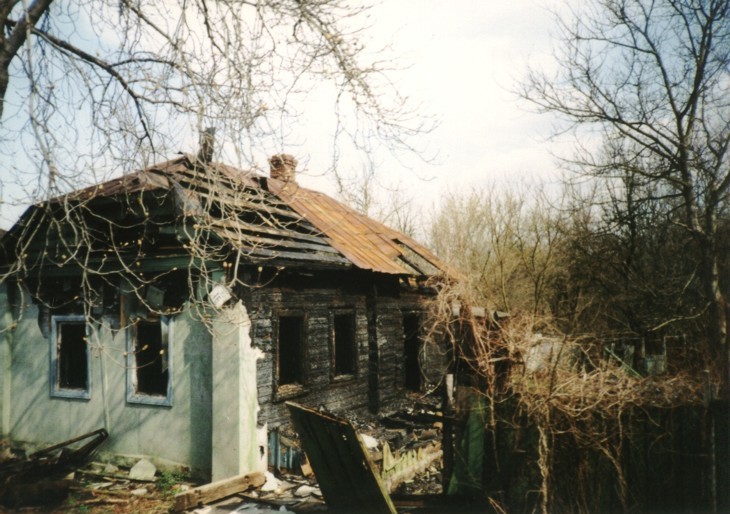
The Pripyat ferris wheel, seen from inside the town's Palace of Culture: photo by Richard Adams, February 2006
It was not a case of love at first sight: the first time I saw Stalker I was slightly bored and unmoved. I wasn't overwhelmed (to put it slightly stupidly, I had no idea that, thirty years later, I would end up writing an entire book about it), but it was an experience I couldn't shake off. Something about it stayed with me. I was living in Putney at the time and one day my then-girlfriend and I went walking in Richmond Park. It was autumn and a bird flew over the sloping ground towards a clump of trees, flapped and flew in a way that was strangely reminiscent of the way that second bird had flown into this vast room of sand. I wanted to see the film again immediately after that, and since then the desire to see it again -- and again and again -- has never gone away.* Until now.
* I may have wanted to see it again immediately but that was impossible. I had to wait until it was showing at a cinema again. Of course it's fantastically convenient, being able to see Stalker -- or at least to refer to it -- at home, on DVD, whenever the urge takes one. But I liked the way that my visits to the Zone were at the mercy of cinema schedules and festival programmes. In London or in any other city where I happened to be living I always looked through Time Out or Pariscope or the Village Voice in the hope that Stalker would be playing. If it was showing somewhere, then seeing it became a priority, an event that gave shape to the surrounding week. Like this, the Zone retained its specialness, its removal from the everyday (of which it remained, at the same time, a part). Getting there was always a little expedition, a cinematic pilgrimage. As was entirely appropriate to the Zone, the film changed slightly, manifested itself differently according to where it happened to be found: the fact that I was seeing Stalker in a tiny cinema in the Fifth arrondissement of Paris -- the same cinema, in fact, where I had sat through L'Avventura -- made it a slightly different experience to seeing it as part of a Tarkovsky retrospective at Lincoln Center in New York. But what about the possibility of a cinema as semipermanent pilgrimage site? Bresson believed that the riches offered by certain films were so inexhaustible that 'there ought to be in Paris one quite small, very well equipped cinema, in which only one or two films would be shown each year.' Taking this a stage further, how about a cinema dedicated to showing Stalker exclusively?
-- Geoff Dyer: from Zona: A Book About a Film About a Journey to a Room (Pantheon, 2012)

Former housing blocks in Pripyat, Ukraine, abandoned city near Chernobyl: photo by Slawojar, April 2001
Geoff Dyer's books have proliferated so thickly in recent years as to comprise a veritable swarm.
It's all one continuing open-ended story, really. The Story of Geoff: an overarching, divagatory, obsessive-quest tale of Geoff tracking his own childhood, raw youth, adult interests, adventures, preoccupations, feelings, tastes in films, books, and so on.
The latest chapter in the saga is an ambitious new book-length stalking of Stalker, Andrei Tarkovsky's slow, bleak, portentous, sometimes luminous 1979 art-house classic and Dyer's all-time favourite movie.
It may have been the absolutely linear simplicity of Stalker's storyline that drew Dyer. The linear storyline would be a point of stability, a sort of spaceport from which to wander off on one's floating, extended-air-line, antigravitational hobbyhorses.
There are certainly humorous and original moments here, especially in the early parts of the book, in which Dyer individualizes the characters in the film, perhaps even better than does Tarkovsky himself, and renders them (almost) credible in human terms as confused pilgrims in some gloomy, swampy post-civilizational landscape, self-tasked with making their way to a prohibited, mysterious, perhaps other-dimensional Zone. But Dyer soon wearies of the original structural plan, i.e. to provide a shot-by-shot transcription and commentary on each of the 142 shots in a 163 minute, virtually action-free movie. By page 186, the usually ebullient author appears to be losing a bit of steam, and his writerly concentration begins to flag accordingly. With the job yet undone and confidence wavering, he projects forward to a post-publication future riddled by might-have-beens:
Then you see that actually those big desires and hopes, your wishes turned out to be not so deep at all, that actually even to consider life and writing in terms of a single wish is absurd, that there are numerous wishes and numerous books to be written -- further extensions (more rooms) to be built, more beer to be drunk... You wonder if you wouldn't have been better off summarizing a different film, Where Eagles Dare, say, or writing a different book, about tennis perhaps... perhaps I should say what it is that I most want from -- what is my deepest wish for -- this book. Easy: success. Success that, by definition, will be enormous success.... the original wish has been updated and upgraded because I'm now thinking that this summary that is the opposite of a summary does have some commercial appeal -- in an admittedly niche sort of way --- and is actually deserving of serious critical attention, maybe even a little prize of some kind.
Allowed the chance to do whatever he wants, Dyer has chosen to do an extremely unlikely thing, and almost but not quite pulled it off.
*****

The Zone (Zone 24), Chernobyl, 24 years after: photo by Lukasz1911, 2010
Geoff Dyer has written that the easy passage from subject to subject in his work has always depended on an ability to forget the last one before starting out on the next.
I was twenty when I read Hazlitt's "First Acquaintance with Poets" and knew immediately that I wanted to emulate this man who had "loitered [his] life away, reading books, looking at pictures, going to plays, hearing, thinking, writing on what pleased [him] best." What could be better (assuming, of course, that you substitute "films" for "plays")? A crucial part of such a life is that you loiter -- with no intent of entering -- outside of the academy, unhindered by specialization (obviously) and the rigors of imposed method. Increasingly at ease with the vagaries of my nature, I came to relish the way that getting interested in one thing led to my becoming very interested in something else -- so interested, in fact, that I often lost interest in whatever it was that, a little while previously, had transfixed me utterly.
-- from Otherwise Known as the Human Condition: Selected Essays and Reviews (2011)
One might read Dyer's career to date as an experiment in cultural loitering with intent, a cultivated, elegant "high" form of literary vagrancy.

House in a village near Pripyat, Ukraine, abandoned after Chernobyl nuclear accident: photo by Slawojar, April 2001
Familiar signature and trademark of the Geoff Dyer Style: a brilliant avoidance of ostensible subject matter, executed by a likeable, self-mocking, frequently bewildered-by-things comic authorial persona. The Style this time round must bear the full weight of the job at hand, as there is so little subject matter, really, to avoid. Merely the one film, in which virtually nothing happens. In Dyer's last book, The Missing of the Somme, there was actual, substantial historical subject matter to be skirted. This time, not so much. Absent the subject matter, The Style is left to go it alone. And we find then that what has worked so well for Dyer in the past becomes here more variable in success.
What are we to make, for instance, of a four-page, tangential, text-interrupting footnote in which the auteur relates his conviction -- a conviction shared by his beloved wife, he informs us, and we see her there, sharing it, alongside him, in the conspiratorial darkness of the cinema -- that his wife is an exact look-alike of the radiantly, lustrously beautiful Irish movie actress Natascha McElhone, who plays the role of Rheya in Steven Soderbergh's 2002 remake of the Tarkovsky sci-fi flick Solaris?
The most interesting thing about it [by "it" Dyer means the Tarkovsky remake in which Ms. McElhone had acted] was that from the start Natasha McElhone looked rather like my wife. After a while this became so striking that I whispered to my wife, "She looks incredibly like you." "I know," my wife whispered back. This resemblance deepened as the film continued. With every subsequent death and reincarnation Natasha McElhone came to resemble my wife more and more closely until, about halfway through, it was exactly like watching my wife up there on-screen...
Although I was deluded in thinking that it was my wife on-screen, this delusion was encouraged by the film, to the extent that I was more deeply implicated in the on-screen drama than I had ever been before.
It is this Dyeresque space-ocean of self-implication which now, with Zona, deepens and complicates itself -- causing us to pause and discover perhaps a black hole of Geoff located beyond the event horizon of Not-Geoff, into which all the dying stars in the galaxy of Geoff may one distant day tumble and vanish.
But not just yet.
*****
View of Chernobyl from roof of a building in Pripyat, Ukraine: photo by Jason Minshull, 2007
The literary device of the extended footnote is of course hardly a Geoff Dyer invention. Claims have reasonably been put forward for the seventeenth century philosopher Pierre Bayle's amazing Historical and Critical Dictionary (1697) as the West's first salient hypertextual document. Each short entry in Bayle's work is followed by a footnote; these footnotes commonly run on to a half dozen times again the length of the bit of text being footnoted, and themselves carry most of the weight of Bayle's argument. The argument is an apology for Fideistic skepticism, a risky subject upon which Bayle had grounds to fear censorship. In his case the footnoting is a defensive strategy. With Dyer the footnoting feels more like a kind of irreverent counter-attack directed at his putative subject, the overserious, somewhat humourless, slightly "priggish" Tarkovsky.
Ruminating a few years ago upon Rebecca West's masterpiece Black Lamb and Grey Falcon, Dyer gave away this revealing hint about his own approach: "To paraphrase Italo Calvino's comment on The Ruins of Kasch by Roberto Calasso, Black Lamb and Grey Falcon takes up two subjects: the first is Yugoslavia, and the second is everything else."
One of the tricks central to Dyer's strategy in writing is to drop in a bit of subject matter, much as a musical motif, and then appear to turn away, only to return later. Anything to keep the music -- the unending "everything else" -- going. We were on Rebecca West, a moment ago, but shall not so soon forget Italo Calvino.
In one of his 1985 Harvard lectures, addressing the theme of "Quickness", Calvino turns to the greatest masterpiece of digression in all literature, Laurence Sterne's The Life and Opinions of Tristram Shandy, Gentleman. The central metaphor of Shandy, a book about "everything else", Calvino reminds us, is the act of winding (and unwinding) a clock.
But what does the clock tell us? Carlo Levi writes in an introduction to Laurence Sterne's Tristram Shandy:
"The clock is Shandy's first symbol. Under its influence he is conceived and his misfortunes begin, which are one and the same with this emblem of time. Death is hidden in clocks, as Belli said; and the unhappiness of individual life, of this fragment, of this divided, disunited thing, devoid of wholeness: death, which is time, the time of individuation, of separation, the abstract time that rolls toward its end. Tristram Shandy does not want to be born because he does not want to die. Every means and every weapon is valid to save oneself from death and time. If a straight line is the shortest distance between two fated and inevitable points, digressions will lengthen it; and if these digressions become so complex, so tangled and torturous, so rapid as to hide their tracks, who knows -- perhaps death may not find us, perhaps time will lose its way, and perhaps we ourselves can remain concealed in our shifting hiding places."
*****

Chernobyl: The Dangerous View (after the explosion at Reactor 4 the people of Pripyat flocked to the railway bridge just outside the city to get a good view of the reactor and see what had happened; initially, everyone was told that radiation levels were minimal and that they were safe; however, much of the radiation proved to have been blown onto this bridge in a huge spike, and the levels were very nearly lethal): photo by Ben Fairless, 2008
One reckons Italo Calvino (and Laurence Sterne) would have picked out the thematic kernel -- Time as metaphor for everything -- hidden within this characteristic bit of Dyeresque wandering, early on in Zona:
You know that expression “famous last words”? We are naturally curious about people’s last words, but it would be interesting to compile an exhaustive list of the first words -- not just sounds, actual words -- spoken in a film, run them through a computer, and subject the results to some kind of processing and analysis. In this film the first words are spoken by the wife and they are: “Why did you take my watch?” Yes, the film’s hardly started, she’s only just woken up, and, from a husbandly point of view, she’s already nagging. Nagging him and calling him a thief. No wonder he wants out. But of course we’re also getting the big theme introduced: time. Tarkovsky is saying to the audience: Forget about previous ideas of time. Stop looking at your watches, this is not going to proceed at the speed of Speed, but if you give yourself over to Tarkovsky time, then the helter-skelter mayhem of The Bourne Ultimatum will seem more tedious than L’Avventura. “I think that what a person normally goes to the cinema for is time,” Tarkovsky has said, “whether for time wasted, time lost, or time that is yet to be gained.” This sentiment is only a couple of words away from being in perfect accord with something even the most moronic cinemagoer would agree with. Those words are "a good", as in “What people go to the cinema for is a good time, not to sit there waiting for something to happen.” (Some people lie outside any kind of consensus of why we go to the cinema. They don’t go to the cinema at all. For Strike, a character in Richard Price’s novel Clockers, a movie, any movie, is just “ninety minutes of sitting there” -- a remark that could be taken as a negative endorsement of Tarkovsky’s claim.)
___
She expands on this notion of time -- she’s lost her best years, has grown old -- while the man is brushing his teeth. As she does so, you’re reminded again of Antonioni, because the plain truth is she’s no Monica Vitti. Frankly, the combination of nagging and permanently faded looks seems like a compelling incentive to leave. She lays a whole guilt trip on him, but the usual terms -- you only think of yourself -- are reversed, given a kind of Dostoyevskian twist: Even if you don’t think of yourself ...
She begs him to stay but, as she does so, you can see that she knows it’s in vain, that he’s going -- even though he’s not actually said where he’s going. She says he’ll end up in prison. He says that everywhere’s a prison. Good answer. But a bad sign, marriagewise. It would seem that their relationship has got to the point where the default mode of communication is to bicker, quarrel, and contradict each other. It’s not a lot of fun, this mode, but it’s easy to get the hang of and immensely difficult to get out of once you’re in it: a prison, in fact. One assumes the man’s answer is intended metaphorically but the film often makes us wonder about when and where it is set and what its relationship is to the world beyond the screen. Stalker was made in the late 1970s, not the thirties or the fifties when the Soviet Union was a vast prison camp, when, in prison-camp slang (as Anne Applebaum points out in Gulag), “the world outside the barbed wire was not referred to as ‘freedom,’ but as the bolshaya zona, the ‘big prison zone,’ larger and less deadly than the ‘small zone’ of the camp, but no more human -- and certainly no more humane.” By the time of Stalker, Communism had become, in Tony Judt’s words, “a way of life to be endured” (which sounds, incidentally, like an alternative translation of koyaanisqatsi, the Hopi Indian word meaning -- as anyone who has ever enjoyed a couple of bong hits already knows -- “way of life needing change” or “life out of balance”). Stalker is not a film about the Gulag, but the absent and unmentioned Gulag is constantly suggested, either by Stalker’s zek haircut or by the overlapping vocabulary. As we will discover, the most perilous part of the Zone (zona) is the so-called "meat grinder", another prisoners' term for the procedures of "the Soviet repressive system itself."
After Stalker leaves, his wife has one of those sexualized fits (nipples prominently erect) of which Tarkovsky seems to have been fond, writhing away on the hard floor in a climax of abandonment.
He, on the other hand, like many men before and since, is on his way to the pub, making his way through railway sidings, beautifully desolate and puddly, in the postindustrial fog.
As the man makes his way across the tracks, a voice-over says everything's "hopelessly boring" -- a remark that makes one wonder how quickly a film can become boring. Which film holds the record in that particular regard? And wouldn't that film automatically qualify as exciting and fast-moving if it had been able to enfold the viewer so rapidly in the itchy blanket of tedium? (Or perhaps one of the novelties of our era is the possibility of instant boredom -- like instant coffee -- as opposed to a feeling that has to unfold gradually, suffocatingly, over time.)
It may be that this project was rife with moments when Dyer felt not only dwarfed in seriousness by but impaled like an entomological specimen upon the sombre genius of Andrei Tarkovsky. It is in moments like this --
those sexualized fits (nipples prominently erect) of which Tarkovsky seems to have been fond
-- that he gets his own back.
*****

Radioactivity warning sign hangs on barbed wire outside a café in Pripyat, Ukraine, town abandoned after Chernobyl nuclear accident: photo by D. Markosian, One Day in the Life of Chernobyl / VOA News, 26 March 2011Slawojar, April 2001
The above-quoted passage on Time from Zona actually occupies less than half the available space of the pages on which it occurs. Four extended footnotes take up the remainder of those pages. (As the book gets longer, the relative proportion of text-body to footnote-length dwindles, as the footnotes, over the course of the work, gradually drown-out the text in what seems an inexorable, if not also a planned, overwhelming incursion of excurses.) In these extended footnotes -- think of them as the rooms through which the reader must journey in search of a Room that isn't there -- Geoff wanders.... and wanders.
To take for example the four protracted footnotes just mentioned. Following their path through the page-space, across the southern-hemisphere regions of the physical object of the book, one finds oneself drifting, like a bit of flotsam swirling upon a fitful eddy, from industry gossip about the casting of Stalker to desultory observations on "the allure and semiromantic mythology" of the Gulag to personal reminiscences of a dinner-party in Paris: "... I do remember thinking, when one of the women said that she and her husband were going to have a poster of Lenin above their bed, that that was something so ridiculous, so preposterously French, it might have been a quote from a Godard film, one of the ones he made after Sympathy with the Devil with the Rolling Stones, an experience that led Mick Jagger to remember of the great auteur, 'He's such a fucking twat.'"
It's the Revenge of Geoff: Take that, Masters of the Cinema!

Radioactivity sign on hill at east end of Red Forest (near Chernobyl): photo by Timm Suess, 26 March 2011
Entrance to the Zone of Alienation around Chernobyl: photo by Slawojar, 23 2006




4 comments:
Lovely. What a fine avalanche of a post. Treasures abound amid the ruins: prisons within prisons; Time and its meanings and vectors; this one thing vs. all the rest. Ulysses S. Grant confessed that he could recognize just two tunes when they were played: “One is Yankee Doodle Dandy. The other one isn’t.”
And that final picture, Zone of Alienation, as summation and coda. It sticks in the mind, as metaphor for an age. “I usta’ woik in dat town,” as some radio comedian of a bygone era liked to declare.
Yours is, I say, far better than both of the other reviews I read, quite by chance, earlier today. Lots to chew on here, Tom. Thanks.
Hazen and Brad, thank you for being such careful readers.
Hazen, I've been collecting photos from the Zone of Alienation for a number of years. They seem to speak parabolically, perhaps better than any other set of images, of the historical/post-historical fact of "Man"'s poor custodianship of the planet given him.
The photographic images made in the vicinity of Chernobyl by occasional (anxious) visitors seem to me to speak more clearly and forcefully than the images of Tarkovsky's muddled imaginal romance; but Tarkovsky's film, too, becomes part of the substance of the bleak postindustrial pre-Apocalyptic mythos.
Keeping in mind the film preceded the Chernobyl incident by some years: this certainly lends a sense of historical prescience.
(By the by, the best film I've seen about the effects of Chernobyl is a virtually unknown, starkly riveting documentary about the irradiated reindeer herds of Lappland, and the concurrent destruction of the traditional culture of their tenders, made by the Swedish documentarist Stefan Järl.)
As for Dyer's quick tour of this whole area of associations, for me the most interesting aspect was the industrious avoiding of the subject, a familiar comic strategy for this writer; though this time it's not quite so easy to tell who the joke's on.
Sterne's genius at keeping the music going by means of serial digression has as its greatest virtue the warmth, affection and sheer hilarity generated by the exercise. Certainly one of the great gifts ever offered in the art of the book. (And at no point in the eight volumes of it is the reader tempted to fancy the image of a self-pleased authorial persona posing before the adoring mirror of a bought readership, by the way.)
As to those other reviews, Brad, all I can say is that a congenial, disarming, facile, lightweight, well-dressed, prizewinning, selfregarding, reverse-chic-canny, cultural-label-conversant, in-vogue, made-for-an-age-without-an-attention-span talent may reasonably be expected to be widely regarded as the Latest Big Thing. This seems a fact related to the cross-media triumph of a generic, watered-down, post-postmodern "New Nothing" form of pseudo-literature.
One is not allowed to knock such a phenomenon. Believe it.
As Hazen says, “a fine avalanche of a post” and I might add, one that does not leave you the impression of being snowed under. =:o)
By the way, another fine writer who used the footnote brilliantly was the late Patrick Leigh Fermor.
Post a Comment